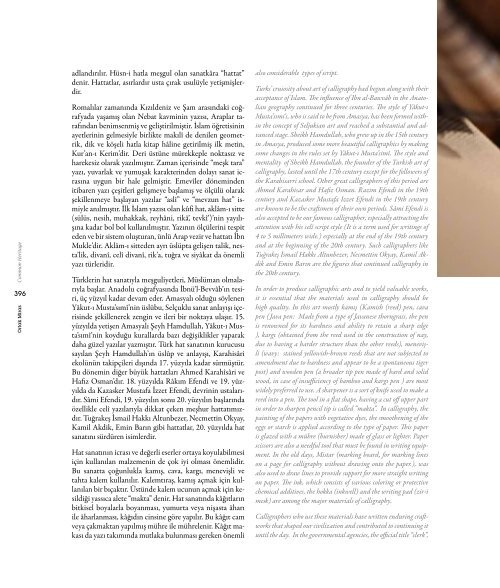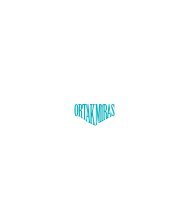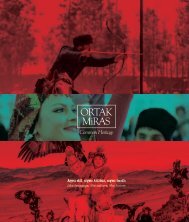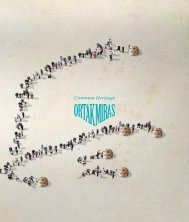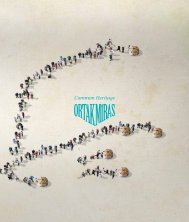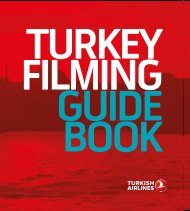You also want an ePaper? Increase the reach of your titles
YUMPU automatically turns print PDFs into web optimized ePapers that Google loves.
Common Heritage<br />
396<br />
Ortak Miras<br />
adlandırılır. Hüsn-i hatla meşgul olan sanatkâra “hattat”<br />
denir. Hattatlar, asırlardır usta çırak usulüyle yetişmişlerdir.<br />
Romalılar zamanında Kızıldeniz ve Şam arasındaki coğrafyada<br />
yaşamış olan Nebat kavminin yazısı, Araplar tarafından<br />
benimsenmiş ve geliştirilmiştir. İslam öğretisinin<br />
ayetlerinin gelmesiyle birlikte makılî de denilen geometrik,<br />
dik ve köşeli hatla kitap hâline getirilmiş ilk metin,<br />
Kur’an-ı Kerim’dir. Deri üstüne mürekkeple noktasız ve<br />
harekesiz olarak yazılmıştır. Zaman içerisinde “meşk tara”<br />
yazı, yuvarlak ve yumuşak karakterinden dolayı sanat icrasına<br />
uygun bir hale gelmiştir. Emevîler döneminden<br />
itibaren yazı çeşitleri gelişmeye başlamış ve ölçülü olarak<br />
şekillenmeye başlayan yazılar “aslî” ve “mevzun hat” ismiyle<br />
anılmıştır. İlk İslam yazısı olan kûfi hat, aklâm-ı sitte<br />
(sülüs, nesih, muhakkak, reyhâni, rikâ’, tevkî’)’nin yayılışına<br />
kadar bol bol kullanılmıştır. Yazının ölçülerini tespit<br />
eden ve bir sistem oluşturan, ünlü Arap vezir ve hattatı İbn<br />
Mukle’dir. Aklâm-ı sitteden ayrı üslüpta gelişen talik, nesta’lik,<br />
divanî, celî divanî, rik’a, tuğra ve siyâkat da önemli<br />
yazı türleridir.<br />
Türklerin hat sanatıyla meşguliyetleri, Müslüman olmalarıyla<br />
başlar. Anadolu coğrafyasında İbnü’l-Bevvâb’ın tesiri,<br />
üç yüzyıl kadar devam eder. Amasyalı olduğu söylenen<br />
Yâkut-ı Musta’sımî’nin üslûbu, Selçuklu sanat anlayışı içerisinde<br />
şekillenerek zengin ve ileri bir noktaya ulaşır. 15.<br />
yüzyılda yetişen Amasyalı Şeyh Hamdullah, Yâkut-ı Musta’sımî’nin<br />
koyduğu kurallarda bazı değişiklikler yaparak<br />
daha güzel yazılar yazmıştır. Türk hat sanatının kurucusu<br />
sayılan Şeyh Hamdullah’ın üslûp ve anlayışı, Karahisâri<br />
ekolünün takipçileri dışında 17. yüzyıla kadar sürmüştür.<br />
Bu dönemin diğer büyük hattatları Ahmed Karahîsâri ve<br />
Hafız Osman’dır. 18. yüzyılda Râkım Efendi ve 19. yüzyılda<br />
da Kazasker Mustafa İzzet Efendi, devrinin ustalarıdır.<br />
Sâmi Efendi, 19. yüzyılın sonu 20. yüzyılın başlarında<br />
özellikle celî yazılarıyla dikkat çeken meşhur hattatımızdır.<br />
Tuğrakeş İsmail Hakkı Altunbezer, Necmettin Okyay,<br />
Kamil Akdik, Emin Barın gibi hattatlar, 20. yüzyılda hat<br />
sanatını sürdüren isimlerdir.<br />
Hat sanatının icrası ve değerli eserler ortaya koyulabilmesi<br />
için kullanılan malzemenin de çok iyi olması önemlidir.<br />
Bu sanatta çoğunlukla kamış, cava, kargı, menevişli ve<br />
tahta kalem kullanılır. Kalemtıraş, kamış açmak için kullanılan<br />
bir bıçaktır. Üstünde kalem ucunun açmak için kesildiği<br />
yassıca alete “makta” denir. Hat sanatında kâğıtların<br />
bitkisel boyalarla boyanması, yumurta veya nişasta âharı<br />
ile âharlanması, kâğıdın cinsine göre yapılır. Bu kâğıt cam<br />
veya çakmaktan yapılmış mühre ile mührelenir. Kâğıt makası<br />
da yazı takımında mutlaka bulunması gereken önemli<br />
also considerable types of script.<br />
Turks’ cruiosity about art of calligraphy had begun along with their<br />
acceptance of Islam. The influence of Ibn al-Bawvâb in the Anatolian<br />
geography continued for three centuries. The style of Yâkut-ı<br />
Musta’sımi’s, who is said to be from Amasya, has been formed within<br />
the concept of Seljukian art and reached a substantial and advanced<br />
stage. Sheikh Hamdullah, who grew up in the 15th century<br />
in Amasya, produced some more beautiful calligraphics by making<br />
some changes in the rules set by Yâkut-ı Musta’simî. The style and<br />
mentality of Sheikh Hamdullah, the founder of the Turkish art of<br />
calligraphy, lasted until the 17th century except for the followers of<br />
the Karahisarri school. Other great calligraphers of this period are<br />
Ahmed Karahisar and Hafiz Osman. Razim Efendi in the 19th<br />
century and Kazasker Mustafa Izzet Efendi in the 19th century<br />
are known to be the craftsmen of their own periods. Sâmi Efendi is<br />
also accepted to be our famous calligrapher, especially attracting the<br />
attention with his celî script style (It is a term used for writings of<br />
4 to 5 millimeters wide.) especially at the end of the 19th century<br />
and at the beginning of the 20th century. Such calligraphers like<br />
Tuğrakeş İsmail Hakkı Altunbezer, Necmettin Okyay, Kamil Akdik<br />
and Emin Barın are the figures that continued calligraphy in<br />
the 20th century.<br />
In order to produce calligraphic arts and to yield valuable works,<br />
it is essential that the materials used in calligraphy should be<br />
high quality. In this art mostly kamış (Kamish (reed) pen, cava<br />
pen (Java pen: Made from a type of Javanese thorngrass, the pen<br />
is renowned for its hardness and ability to retain a sharp edge<br />
), kargı (obtained from the reed used in the construction of nay,<br />
due to having a harder structure than the other reeds), menevişli<br />
(wavy: stained yellowish-brown reeds that are not subjected to<br />
amendment due to hardness and appear to be a spontaneous tiger<br />
post) and wooden pen (a broader tip pen made of hard and solid<br />
wood, in case of insufficiency of bamboo and kargı pen ) are most<br />
widely preferred to use. A sharpener is a sort of knife used to make a<br />
reed into a pen. The tool in a flat shape, having a cut off upper part<br />
in order to sharpen pencil tip is called “makta”. In calligraphy, the<br />
painting of the papers with vegetative dyes, the smoothening of the<br />
eggs or starch is applied according to the type of paper. This paper<br />
is glazed with a mühre (burnisher) made of glass or lighter. Paper<br />
scissors are also a needful tool that must be found in writing equipment.<br />
In the old days, Mistar (marking board, for marking lines<br />
on a page for calligraphy without drawing onto the paper.), was<br />
also used to draw lines to provide support for more straight writing<br />
on paper. The ink, which consists of various coloring or protective<br />
chemical additives, the hokka (inkwell) and the writing pad (zir-i<br />
mesk) are among the major materials of calligraphy.<br />
Calligraphers who use these materials have written enduring craftworks<br />
that shaped our civilization and contributed to continuing it<br />
until the day. In the governmental agencies, the official title “clerk”,


